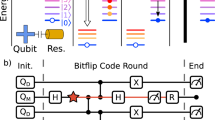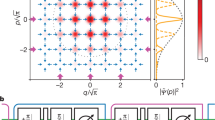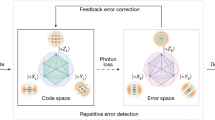Abstract
A quantum system interacts with its environment—if ever so slightly—no matter how much care is put into isolating it1. Therefore, quantum bits undergo errors, putting dauntingly difficult constraints on the hardware suitable for quantum computation2. New strategies are emerging to circumvent this problem by encoding a quantum bit non-locally across the phase space of a physical system. Because most sources of decoherence result from local fluctuations, the foundational promise is to exponentially suppress errors by increasing a measure of this non-locality3,4. Prominent examples are topological quantum bits, which delocalize information over real space and where spatial extent measures non-locality. Here, we encode a quantum bit in the field quadrature space of a superconducting resonator endowed with a special mechanism that dissipates photons in pairs5,6. This process pins down two computational states to separate locations in phase space. By increasing this separation, we measure an exponential decrease of the bit-flip rate while only linearly increasing the phase-flip rate7. Because bit-flips are autonomously corrected, only phase-flips remain to be corrected via a one-dimensional quantum error correction code. This exponential scaling demonstrates that resonators with nonlinear dissipation are promising building blocks for quantum computation with drastically reduced hardware overhead8.
This is a preview of subscription content, access via your institution
Access options
Access Nature and 54 other Nature Portfolio journals
Get Nature+, our best-value online-access subscription
$29.99 / 30 days
cancel any time
Subscribe to this journal
Receive 12 print issues and online access
$209.00 per year
only $17.42 per issue
Buy this article
- Purchase on Springer Link
- Instant access to full article PDF
Prices may be subject to local taxes which are calculated during checkout




Similar content being viewed by others
Data availability
The data that support the plots within this paper and other findings of this study are available from the corresponding author upon reasonable request.
References
Haroche, S. & Raimond, J.-M. Exploring the Quantum (Oxford Univ. Press, 2006).
Fowler, A. G., Mariantoni, M., Martinis, J. M. & Cleland, A. N. Surface codes: towards practical large-scale quantum computation. Phys. Rev. A 86, 032324 (2012).
Kitaev, A. Y. Unpaired majorana fermions in quantum wires. Phys. Uspekhi 44, 131–136 (2001).
Mourik, V. et al. Signatures of Majorana fermions in hybrid superconductor–semiconductor nanowire devices. Science 336, 1003–1007 (2012).
Wolinsky, M. & Carmichael, H. J. Quantum noise in the parametric oscillator: from squeezed states to coherent-state superpositions. Phys. Rev. Lett. 60, 1836–1839 (1988).
Leghtas, Z. et al. Confining the state of light to a quantum manifold by engineered two-photon loss. Science 347, 853–857 (2015).
Mirrahimi, M. et al. Dynamically protected cat-qubits: a new paradigm for universal quantum computation. New J. Phys. 16, 045014 (2014).
Guillaud, J. & Mirrahimi, M. Repetition cat qubits for fault-tolerant quantum computation. Phys. Rev. X 9, 041053 (2019).
Shor, P. Scheme for reducing decoherence in quantum memory. Phys. Rev. A 52, 2493–2496 (1995).
Steane, A. M. Error correcting codes in quantum theory. Phys. Rev. Lett. 77, 793–797 (1996).
Flühmann, C. et al. Encoding a qubit in a trapped-ion mechanical oscillator. Nature 566, 513–517 (2019).
Campagne-Ibarcq, P. et al. A stabilized logical quantum bit encoded in grid states of a superconducting cavity. Preprint at https://arxiv.org/pdf/1907.12487.pdf (2019).
Brooks, P., Kitaev, A. & Preskill, J. Protected gates for superconducting qubits. Phys. Rev. A 87, 052306 (2013).
Albrecht, S. M. et al. Exponential protection of zero modes in Majorana islands. Nature 531, 206–209 (2016).
Lin, Y.-H. et al. Demonstration of protection of a superconducting qubit from energy decay. Phys. Rev. Lett. 120, 150503 (2018).
Earnest, N. et al. Realization of a Λ system with metastable states of a capacitively shunted fluxonium. Phys. Rev. Lett. 120, 150504 (2018).
Smith, W. C., Kou, A., Xiao, X., Vool, U. & Devoret, M. H. Superconducting circuit protected by two-Cooper-pair tunneling. npj Quantum Inf. 6, 8 (2020).
Puri, S., Boutin, S. & Blais, A. Engineering the quantum states of light in a Kerr-nonlinear resonator by two-photon driving. npj Quantum Inf. 3, 18 (2017).
Touzard, S. et al. Coherent oscillations inside a quantum manifold stabilized by dissipation. Phys. Rev. X 8, 021005 (2018).
Tuckett, D. K., Bartlett, S. D. & Flammia, S. T. Ultrahigh error threshold for surface codes with biased noise. Phys. Rev. Lett. 120, 050505 (2018).
Tuckett, D. K. et al. Tailoring surface codes for highly biased noise. Phys. Rev. X 9, 041031 (2019).
Tuckett, D. K., Bartlett, S. D., Flammia, S. T. & Brown, B. J. Fault-tolerant thresholds for the surface code in excess of 5% under biased noise. Preprint at https://arxiv.org/pdf/1907.02554.pdf (2019).
Grimm, A. et al. The Kerr-cat qubit: stabilization, readout and gates. Preprint at https://arxiv.org/pdf/1907.12131 (2019).
Puri, S. et al. Bias-preserving gates with stabilized cat qubits. Preprint at https://arxiv.org/pdf/1905.00450 (2019).
Leghtas, Z. et al. Hardware-efficient autonomous quantum memory protection. Phys. Rev. Lett. 111, 120501 (2013).
Gottesman, D., Kitaev, A. & Preskill, J. Encoding a qubit in an oscillator. Phys. Rev. A 64, 012310 (2001).
Carmichael, H. J. Statistical Methods in Quantum Optics 2 (Springer, 2008).
Sank, D. et al. Measurement-induced state transitions in a superconducting qubit: beyond the rotating wave approximation. Phys. Rev. Lett. 117, 190503 (2016).
Gao, Y. Y. et al. Programmable interference between two microwave quantum memories. Phys. Rev. X 8, 021073 (2018).
Lescanne, R. et al. Escape of a driven quantum Josephson circuit into unconfined states. Phys. Rev. Appl. 11, 014030 (2019).
Wang, C. et al. Measurement and control of quasiparticle dynamics in a superconducting qubit. Nat. Commun. 5, 5836 (2014).
Vrajitoarea, A., Huang, Z., Groszkowski, P., Koch, J. & Houck, A. A. Quantum control of an oscillator using a stimulated Josephson nonlinearity. Nat. Phys 16, 211–217 (2019).
Verney, L., Lescanne, R., Devoret, M. H., Leghtas, Z. & Mirrahimi, M. Structural instability of driven Josephson circuits prevented by an inductive shunt. Phys. Rev. Appl. 11, 024003 (2019).
Touzard, S. et al. Gated conditional displacement readout of superconducting qubits. Phys. Rev. Lett. 122, 080502 (2019).
Reagor, M. et al. Quantum memory with millisecond coherence in circuit QED. Phys. Rev. B 94, 014506 (2016).
Bruno, A. et al. Reducing intrinsic loss in superconducting resonators by surface treatment and deep etching of silicon substrates. Appl. Phys. Lett. 106, 182601 (2015).
Sank, D. et al. Measurement-induced state transitions in a superconducting qubit: beyond the rotating wave approximation. Phys. Rev. Lett. 117, 190503 (2016).
Pop, I. M. et al. Measurement of the effect of quantum phase slips in a Josephson junction chain. Nat. Phys. 6, 589–592 (2010).
Lescanne, R. et al. Escape of a driven quantum Josephson circuit into unconfined states. Phys. Rev. Appl. 11, 014030 (2019).
Touzard, S. et al. Coherent oscillations inside a quantum manifold stabilized by dissipation. Phys. Rev. X 8, 021005 (2018).
Leghtas, Z. et al. Confining the state of light to a quantum manifold by engineered two-photon loss. Science 347, 853–857 (2015).
Gao, Y. Y. et al. Programmable interference between two microwave quantum memories. Phys. Rev. X 8, 021073 (2018).
Verney, L., Lescanne, R., Devoret, M. H., Leghtas, Z. & Mirrahimi, M. Structural instability of driven Josephson circuits prevented by an inductive shunt. Phys. Rev. Appl. 11, 024003 (2019).
Reed, M. D. et al. Fast reset and suppressing spontaneous emission of a superconducting qubit. Appl. Phys. Lett. 96, 203110 (2010).
Frattini, N. E., Sivak, V. V., Lingenfelter, A., Shankar, S. & Devoret, M. H. Optimizing the nonlinearity and dissipation of a snail parametric amplifier for dynamic range. Phys. Rev. Appl. 10, 054020 (2018).
Acknowledgements
We acknowledge fruitful discussions with P. Rouchon and C. Smith. Z.L. acknowledges support from ANR project ENDURANCE and EMERGENCES grant ENDURANCE of Ville de Paris. A.S. acknowledges support from ANR project HAMROQS. The devices were fabricated within the consortium Salle Blanche Paris Centre. This work has been supported by the Paris Île-de-France Region in the framework of DIM SIRTEQ. M.M. acknowledges support from ARO under grant no. W911NF-18-1-0212. Z.L. acknowledges Mines-ParisTech as his primary affiliation.
Author information
Authors and Affiliations
Contributions
R.L. designed, fabricated and measured the device, and analysed the data. R.L. and Z.L. conceived the ATS element with help from B.H. and T.P. R.L. and Z.L. wrote the paper with input from all authors. M.V. fabricated the parametric amplifier. T.K. and M.D. provided experimental support. A.S. and M.M. provided theory support. Z.L. managed the project. All authors contributed to extensive discussions of the results.
Corresponding author
Ethics declarations
Competing interests
The authors declare no competing interests.
Additional information
Peer review information Nature Physics thanks Christopher Eichler and the other, anonymous, reviewer(s) for their contribution to the peer review of this work.
Publisher’s note Springer Nature remains neutral with regard to jurisdictional claims in published maps and institutional affiliations.
Extended data
Extended Data Fig. 1 Measured system parameters at the ATS working point.
The pump shifts the cat-qubit resonator and buffer frequencies. The frequencies in the absence of the pump are noted ωa∕b,0 and those in its presence are denoted ωa∕b. The Kerr couplings χmn enter the full Hamiltonian in the form − χmnm†mn†n when m ≠ n and \(-\frac{{\chi }_{mm}}{2}{{m}^{\dagger }}^{2}{m}^{2}\), where m, n denote the mode indices.
Extended Data Fig. 2 Underlying parameters of the cat-qubit and buffer resonators.
Measured and estimated circuit parameters (left), and their corresponding dipole energies (right).
Extended Data Fig. 3 Full device layout.
a, False color optical image of the ATS. Note that the 5 junction symbols are separated for clarity, the actual junctions are much closer and centered in the middle of the arm. b, False color optical image of the buffer. The buffer (red) is strongly coupled to its transmission line via an interdigitated capacitor (top). It is also capacitively coupled to the cat-qubit resonator (blue). This is actually a picture of a twin sample where this coupling was smaller. In panel c, the real size of the coupling capacitor is shown. (c) Full device layout. The cat-qubit resonator is coupled on its other side to a transmon qubit, itself coupled to a readout resonator which together enable to perform the cat-qubit tomography. After the interdigitated capacitor, the buffer input is filtered via three λ∕4-stub filters. These stop-band filters are centered at the cat-qubit resonance frequency to mitigate its direct coupling to the input line of the buffer44 (b). The on-chip hybrid along the pump path (purple), equally splits the pump tone to RF-flux bias the ATS with the right symmetry. The black lines linking two dots are a schematic representation of the crucial wirebonds of the device. The wirebonds linking the pump input to the on-chip hybrid where implemented to reduce the area of the loop delimited by the center conductor and the ground plane, leading to a reduced sensitivity to flux noise.
Extended Data Fig. 4 RF and DC wiring of the dilution refrigerator.
Note that the pump and drive tones are attenuated at the base plate via directional couplers so that the attenuated power is dissipated at higher fridge stages, far from the sample. The IΣ DC current and the RF pump signal are combined at 20 mK with a bias-tee. We have used a homemade ‘Snail Parametric Amplifier’ (SPA)45.
Extended Data Fig. 5 Flux dependence.
a, Buffer spectroscopy. Phase of the reflected probe signal (colormap) on the buffer port as a function of \({I}_{_{\Sigma }}\) (x-axis) and probe frequency (y-axis). The buffer frequency follows an arch-like pattern typical of SQUID-based devices. The probing frequency range is limited to 3-8 GHz due to the 4-8 GHz circulator on the output line. The black dashed line represents the expected buffer/cat-qubit frequency for the best fitting parameter set. The slight aperiodicity may be explained by small asymmetries in the loop areas of the ATS. b, Cat-qubit resonator two-tone spectroscopy. A continuous probe is applied on the cat-qubit resonator at various frequencies (y-axis) and a second tone attempts to π-pulse the qubit on resonance. When the probe populates the cat-qubit, the qubit shifts in frequency due to the cross-Kerr coupling, and is insensitive to the π-pulse. The resulting qubit occupation is plotted in color and we repeat the experiment for various values of \({I}_{_{\Sigma }}\) (x-axis). The black dashed line represents the expected buffer/cat-qubit frequency for the best fitting parameter set. The black vertical line corresponds to a flux bias were the buffer is at the qubit frequency resulting in a strong decrease in the qubit lifetime. c, For each value of \({I}_{_{\Sigma }}\) (x-axis) and \({I}_{_{\Delta }}\) (y-axis), we extract the buffer frequency from a spectroscopy measurement (panel a) and report it in color (white is when the resonance frequency is beyond the measurement range). Contrary to what they were designed for, the two flux lines do not perfectly apply symmetric (\({I}_{_{\Sigma }}\)) and antisymmetric (\({I}_{_{\Delta }}\)) bias on the ATS. We compensate for this imbalance while taking the data by shifting the \({I}_{_{\Sigma }}\) span for each value of \({I}_{_{\Delta }}\) as indicated on the x-axis label. Data were only taken on the area outside the hatched regions to prevent the heating of the dilution refrigerator beyond a tolerable temperature. The grey dashed-rectangle corresponds to the flux range presented in Fig. 2 of the main text. d, Simulated flux dependence of the buffer mode for the best fitting parameter set.
Extended Data Fig. 6 Tuning the pump and drive frequencies.
a, Reflected relative drive amplitude (VNA measurement) as a function of drive frequency (x-axis) and pump frequency (y-axis). When ωp = 2ωa − ωd, a sharp feature indicates that the two-to-one photon exchange is resonant and as expected, it has a slope − 1. To observe this feature, we switch to the basis Δ = (Δpump + Δdrive)∕2, Δb = (Δpump − Δdrive)∕2, the orientation of which is given by the white dashed lines. b,c, Reflected relative drive amplitude (color) and parity of the cat-qubit resonator (red) as a function of Δ (x-axis) and Δb (y-axis) for increasing drive amplitude (top to bottom). The drive amplitude is expressed in units of the cat size ∣α∞∣2 which is calibrated using the data of Extended Data Fig. 7. (c) When the two-to-one photon exchange is resonant, the cat-qubit resonator is displaced and the parity drops to 0 if we measure after a time greater than \({\kappa }_{a}^{-1}\). We also perform the cat-qubit resonator tomography and verify that the resonator is in a balanced mixture of \({\left|0\right\rangle }_{\alpha }\) and \({\left|1\right\rangle }_{\alpha }\). In all these plots, the white circles correspond to the chosen pump and drive frequencies. We verify that for all used drive amplitudes, this point remains centered in the resonant range. Therefore, we do not need to adapt the drive and pump frequencies when increasing the cat size. d, Cut of the color plot (c) at Δb = 0 representing the parity (open circle) of the cat-qubit steady state as a function of Δ. The relation of Eq. (26) of the supplementary information shows that the frequency window over which a non-trivial state is stabilized in the cavity scales as 2κ2∣α∣2. This enables us to determine κ2 assuming photon loss is the main loss mechanism. We fit (solid line) the measured parity with the expected steady-state parity (QuTiP) where the two fitting parameters are the parity contrast and κ2. We find κ2∕2π = 40 kHz.
Extended Data Fig. 7 Increasing the cat-qubit size.
a, Measured Wigner distribution of the cat-qubit state as a function of drive amplitude (left to right, top to bottom) after a pump and drive pulse duration of 20μs. b, Fitted cat size ∣α∞∣2 (open circles) as a function of the drive amplitude ϵd. The drive amplitude is expressed in terms of the square root of the photon number the buffer would contain without the conversion process. For each Wigner distribution of panel (a), we fit a sum of two 2D-Gaussian functions (coherent states) diametrically opposed which are separated by a distance 2∣α∞∣. Note that for simplicity, in the main text, we use ∣α∣2 instead of ∣α∞∣2. In the presence of single photon loss at rate κa, we expect ∣α∞∣2 to follow the relation of Eq. (20) of the supplementary information (dashed line): a linear dependence on ϵd when |α|2 > κa∕(2κ2). By fitting this relation to the data, we calibrate the x-axis scaling.
Extended Data Fig. 8 Equivalent circuit diagram.
The cat-qubit resonator (blue) is represented by a linear LC resonator with charging energy EC,a and inductive energy EL,a. It is capacitively coupled through a capacitor of charging energy EC,c to the buffer (red) which consists of a capacitively shunted ATS element. The ATS, introduced in the main text, is formed by two Josephson junctions (crosses) of Josephson energies EJ,1 and EJ,2 split by an inductor of inductive energy EL,b. In practice, this inductor is made out of 5 large Josephson junctions. Flux lines represented as grey inductors thread magnetic flux through the two ATS loops. One recovers the circuit of Fig. 2 by setting φext,1 = π and φext,2 = 0. Not shown here: the buffer is capacitively coupled to a transmission line and the cat-qubit resonator is coupled to a transmon qubit, its readout resonator and a transmission line.
Supplementary information
Supplementary Information
Supplementary Figs. 1–4 and Discussion.
Rights and permissions
About this article
Cite this article
Lescanne, R., Villiers, M., Peronnin, T. et al. Exponential suppression of bit-flips in a qubit encoded in an oscillator. Nat. Phys. 16, 509–513 (2020). https://doi.org/10.1038/s41567-020-0824-x
Received:
Accepted:
Published:
Issue Date:
DOI: https://doi.org/10.1038/s41567-020-0824-x
This article is cited by
-
Observation and manipulation of quantum interference in a superconducting Kerr parametric oscillator
Nature Communications (2024)
-
Universal control of a bosonic mode via drive-activated native cubic interactions
Nature Communications (2024)
-
Observation of Josephson harmonics in tunnel junctions
Nature Physics (2024)
-
Tailored cluster states with high threshold under biased noise
npj Quantum Information (2023)
-
High-fidelity parametric beamsplitting with a parity-protected converter
Nature Communications (2023)



